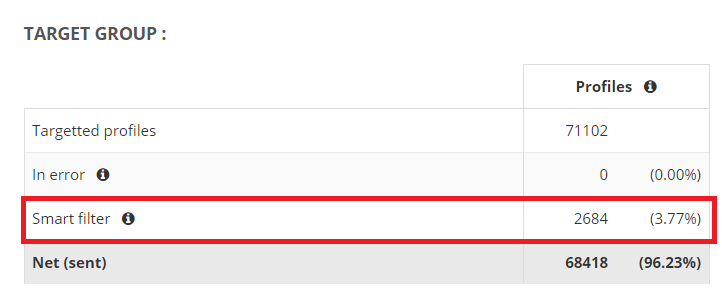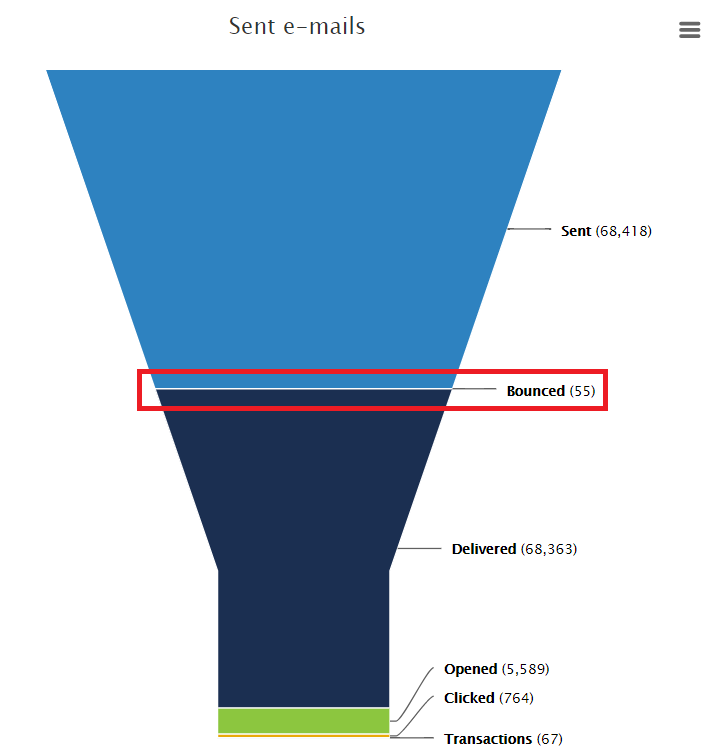Understanding the Smart Filter
Not every email address in your database has good quality. Some of them belong to very engaged profiles, while some others belong to profiles who very rarely open your e-mails.
In some cases, your e-mail might never end up in the inbox of your recipient.
Reasons why an e-mail does not reach the inbox
-
The e-mail address in invalid: the syntax of the e-mail address is false or it has a spelling mistake (for instance, @gmial instead of @gmail)
-
The e-mail address is a spam-trap: a spam-trap is an existing e-mail address used as bait in order to identify bad practices.
-
The address does not exist (anymore) on this domain and will generate a 'hard bounce': these syntactically correct addresses that do not exist anymore will be blocked in long-term quarantine by Actito.
-
The address belongs to a recipient whose mailbox is full: these addresses will generate a 'soft bounce' and will be blocked in a temporary quarantine by ACTITO.
-
The recipient has marked one of your e-mails as spam.
Impact on your deliverability
Each of the reasons explained above will evidently decrease the inbox rate of your campaign, but it is not enough to consider their impact in relation to a single campaign:
Your reputation with e-mail providers and the deliverability of your next campaigns are at stake!
Evidently, while a high complaint rate (e-mail marked as spam) will impact your reputation, this is also the case for spam-traps, which are especially used by providers to identify senders with doubtful practices and to possibly add them to a "blacklist".
But there is more. "Hard bounces" will also decrease your reputation with e-mail providers because, even though they do not impact any real user (the e-mail address does not exist), they highlight bad database management.
ACTITO's solution
In order to keep an optimal reputation, it is therefore necessary to clean up your troublesome addresses after sending a campaign.
While it is important to actively monitor the result of your campaigns (via the reporting) to keep watch of bounces and complaints in order to proactively maintain your deliverability, ACTITO has set up a feature which prevent sending e-mails to addresses flagged as troublesome.
The filter used to improve your deliverability is called the "Smart Filter".
Smart Filter
The "Smart Filter" uses shared knowledge base about your routing history, which includes inbox placements rate, long-term blockings because of spam or hard bounces, repeated temporary quarantines…
Thanks to this knowledge base, Actito artificial intelligence will determine whether including the targeted address in your e-mail campaign is relevant or not.
E-mail addresses flagged as troublesome will be automatically filtered at the sending.

This automatic filter will avoid sending e-mails to addresses with a bad influence on your deliver and you will witness a reduction of the number of bounces.

As such, the reputation of your campaign will improve, which implies reducing the risk of seeing your campaign blocked by e-mail providers.
Your inbox placement rate will improve, which in return will lead to an improvement of your opening rate.
Moreover, thanks to a diminution of e-mails sent to spam-traps, to quarantined or nonexistent addresses, e-mail providers will acknowledge the good management of your database. Your global reputation will improve.
Set Up
The "Smart Filter" is a basic feature of Actito. It is automatically activated for Marketing campaigns.
If you can access the ACTITO "transactional e-mail" option, the 'Smart Filter is not activated for this feature.
The purpose of the "Transactional E-mail" feature is indeed to contact a profile following an interaction started by this very profile (purchase, specific request…). No filter is therefore applied, neither about marketing consent nor about deliverability…).
Good to know
Actito artificial intelligence uses the result of your previous e-mail campaigns to calculate which address to filter. A sending history is therefore necessary for optimal calculation.
